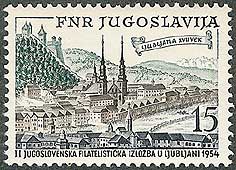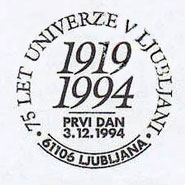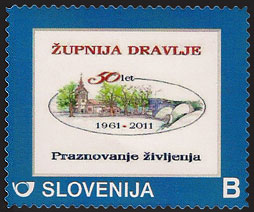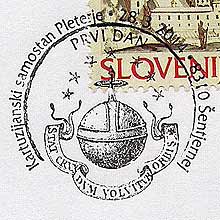Jesuit House in Jurkloster
SLOVENIA, 2009, Scott 834In Jurkloster, Slovenia there are some remains of the Carthusian monastery, which was founded around 1170, by Henrik, the Bishop of Krsko. With a gap of about 10 years, the monastery was active until 1595, when it was closed and the Jesuits took over the church and the monastery for 178 years. When the Jesuits were suppressed in 1773, the monastery and church were pulled down and the present parish church of St. Maurice built.
St. James Church and the Jesuit College, Ljubljana



YUGOSLAVIA, 1954, showing 17th-century Ljubljana, now the capital of
Slovenia, Scott 410
SLOVENIA, 1994, the 75th anniversary of the University of Ljubljana,
Scott 221 and its FDI cancel
The image on the above Yugoslav stamp is based on an etching by J. V. Valvasor in his Die Ehre dess Hertzogthums Crain (Nürnberg 1689): a large townscape of Ljubljana from the 17th century. In the center of the etching and the stamp is the old Cathedral of St. Nicholas with its towering twin spires. That cathedral was pulled down in 1701, and a new cathedral to replace it was built in 1701-1706 by the Jesuit architect Br. Andrea Pozzo, SJ. In the center foreground of the stamp is the single spire of the Church of St. James, built by the Jesuits in 1613-1616; to the church's left by a quarter of the stamp is the octagonal chapel of St. Francis Xavier, built between 1667 and 1670, and about them are the buildings of the Jesuit college. Jesuits arrived in Ljubljana in 1597 and began offering secondary education at once. In 1704 philosophical studies (including mathematics) were added and then theology and canon law. But the college was not authorized to issue degrees, a university prerogative. After the Suppression in 1773, the state took over the Jesuit school.
YUGOSLAVIA, 1974, the bicentenary of the National and University Library in Ljubljana, Scott 1225The dissolved Jesuit college burned down. 637 books were rescued from the fire and were transferred to the newly established library of the Ljubljana Lyceum. The National and University Library in Ljubljana (Narodna in Univerzitetna knjiznica) was established by the Empress Maria Theresa in 1774. The various reincarnations of the school was replaced in 1919 by the University of Ljubljana, which might be regarded as the successor to the original Jesuit institution of higher education.
The Jesuit Churches of Dravlje, Ljubljana

SLOVENIA, 2011, personalized stamp on the 50th anniversary showing both churches;
the text beneath the logo reads: The celebration of life;
details of both churches can be seen better on the logo of the anniversary (right)The parish church in Dravlje, in the northern part of Ljubljana was founded in 1961 and staffed from the beginning and at all times by Jesuits. Fr. Lojze Strubelji, SJ was the first pastor. The Baroque Romanesque church was dedicated to St. Roch. In 1985 a new and modern church was built right next to the old structure and consecrated in 1985 as the Church of the Incarnation of Christ. Its modern design by architect Marko Mušic incorporates the old church as well as the linden-tree-lined promenade. The inner nucleus is a deepened, amphitheatric hall with a simple altar and blue tinted windows that open toward the church of St. Roch and the nearby trees. The area is supplemented by contemporary and uniformly designed fittings. The prevailing material on the altar and its accessories is white marble. The seats, like those in the theatre, rise to the gallery and in dynamic form toward the auxiliary areas. The new church is the seat of the parish; it is maintained and open regularly. This sacred heritage building has a reputation of being the most unusual, balanced and inventively designed sacral building of the second half of the 20th century in Slovenia.
The Charterhouse in Pleterje

SLOVENIA, 2014, the Charterhouse and the FDI cancel, Scott 1033The Pleterje Charterhouse was founded in 1403 by Count Hermann II as the home of the Carthusian order. In the 15th century, it was subject to frequent Turkish incursions and was even destroyed in one of the attacks. From 1591 to 1593, some Charterhouses were in the hands of and administered by the Jesuit Order stationed at Graz. During this time, all the income went to be used for their collegium. In 1595, an agreement between the Carthusian and Jesuit orders was reached. Accordingly, the Carthusian houses of Zice and Bistra stayed with the Carthusian order, Jurklošter went to the Jesuits from Graz, and Pleterje went to the Jesuits resident in Ljubljana, who held it until the Suppression in 1773. It then frequently changed hands until in 1899 it was reacquired by the French Carthusians.



